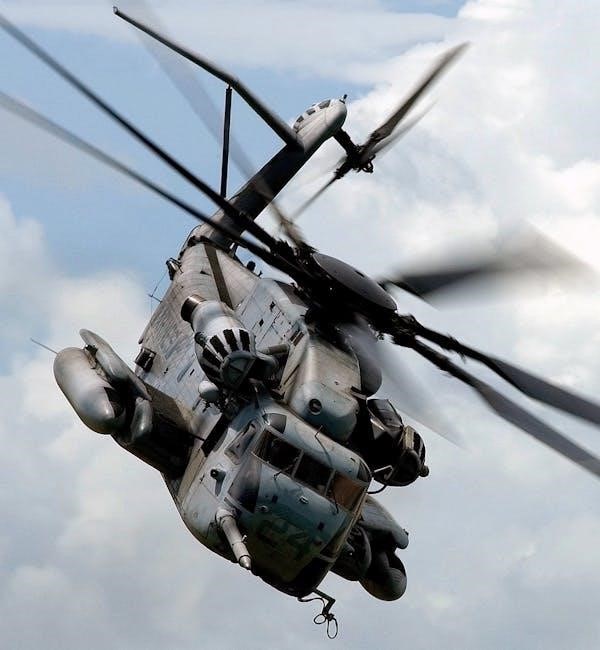
navy 3m manual
The Navy 3M Manual is a revised guide for Ships Maintenance and Material Management, standardizing procedures and assigning responsibilities for effective fleet readiness and safety․
1․1 Purpose of the Navy 3M Manual
The Navy 3M Manual serves as a cornerstone document for standardizing maintenance and material management processes across naval operations․ Its primary purpose is to ensure operational readiness, safety, and efficiency by assigning clear responsibilities and providing detailed procedures for managing ship and shore station equipment․ It emphasizes compliance with established policies and continuous improvement to support mission success․
1․2 Scope of the Manual
The Navy 3M Manual applies to all ships, service craft, small boats, and designated shore station equipment under Naval Sea Systems Command (NAVSEA) cognizance․ It governs maintenance schedules, material management, and documentation standards, ensuring compliance with safety protocols and operational readiness․ The manual integrates procedures for planned maintenance, calibration, and process controls, providing a comprehensive framework for managing naval assets effectively and efficiently․

Background and History
The Navy 3M Manual was established to standardize maintenance practices, evolving from the Chief of Naval Operations’ 1963 initiative to improve fleet operational readiness and efficiency․
2․1 Establishment and Evolution
The Navy 3M Manual was initially established in 1963 under the Chief of Naval Operations to standardize maintenance practices across the fleet․ Over the years, it has evolved to incorporate new policies and technologies, ensuring alignment with modern operational demands and enhancing the efficiency of maintenance and material management processes for naval ships and equipment․
2․2 Historical Development
The Navy 3M Manual has undergone significant updates since its inception, with key revisions in 2003 and 2014 to reflect changing operational needs and organizational restructuring․ These updates enhanced maintenance practices, clarified responsibilities, and incorporated new technologies to improve fleet readiness and safety standards, ensuring the manual remains a critical resource for effective naval operations․

Key Components of the Navy 3M Manual
The manual includes maintenance schedules, material management processes, and quality control measures, ensuring standardized procedures and effective management of naval equipment and resources․
3․1 Maintenance Schedules
Maintenance schedules outline prescribed routines for inspections, repairs, and replacements, ensuring ships and shore equipment remain operational․ These standardized plans cover routine checks, preventive measures, and complex overhauls, aligning with the Planned Maintenance System (PMS)․ Compliance with these schedules is critical for sustaining operational readiness, safety, and efficiency across the Navy’s fleet․
3․2 Material Management Processes
Material management processes within the Navy 3M Manual ensure efficient acquisition, organization, and control of resources․ These processes streamline inventory tracking, procurement, and distribution, optimizing resource allocation․ Standardized procedures minimize waste and ensure availability of critical supplies, supporting maintenance activities and operational readiness across the fleet․
3․3 Quality Control Measures
Quality control measures in the Navy 3M Manual ensure adherence to standards, verifying maintenance and material processes meet operational requirements․ These measures include inspections, audits, and evaluations to maintain consistency and reliability․ Proper documentation and corrective actions address deficiencies, ensuring high performance and safety standards are upheld across all maintenance activities․
Organizational Roles and Responsibilities
The 3M System Coordinator oversees maintenance and material management, while Commanding Officers ensure compliance with procedures and standards, maintaining operational readiness and safety․
4․1 The 3M System Coordinator
The 3M System Coordinator is responsible for implementing, evaluating, and coordinating all aspects of the 3M system․ They ensure compliance with maintenance schedules, manage material processes, and maintain accurate records․ Coordinators must be qualified through the 3M Personnel Qualification Standard (PQS) and are authorized to perform specific maintenance actions․ Their role is critical for operational efficiency and fleet readiness․
4․2 Commanding Officer’s Responsibilities
The Commanding Officer oversees the entire 3M system implementation, ensuring adherence to policies and procedures․ They are responsible for allocating resources, monitoring maintenance activities, and ensuring quality control․ The Commanding Officer also reviews and approves maintenance schedules, ensuring compliance with safety protocols and operational readiness․ Their oversight guarantees the effective execution of the 3M system within their command․

Training and Personnel Qualification
Training programs ensure personnel meet qualification standards, enabling effective maintenance operations․ Formal schooling, correspondence courses, and on-the-job training are essential for 3M system proficiency and compliance․
5․1 Required Training Programs
Required training programs for the Navy 3M Manual include formal schooling, correspondence courses, and Personnel Qualification Standards (PQS)․ These programs ensure sailors understand maintenance procedures, material management, and safety protocols․ Training covers planned maintenance systems, troubleshooting, and equipment operation․ Completion of these programs is mandatory for personnel involved in 3M system activities, ensuring compliance with operational standards and effective fleet readiness․
5․2 Personnel Qualification Standards
Personnel must meet specific qualification standards to perform 3M system tasks․ These include completing the 3M Personnel Qualification Standard (PQS) and obtaining relevant NECs or Job Qualification Requirements (JQR)․ Qualified individuals are authorized to execute maintenance actions, ensuring adherence to safety protocols and operational standards․ These standards ensure personnel competency and compliance with established procedures, critical for maintaining fleet readiness and operational safety․

Implementation Guidelines
The manual outlines standardized procedures for implementing maintenance and material management, ensuring responsibilities are clearly assigned and processes are effectively integrated and monitored across Navy commands․
6․1 Steps for Effective Implementation
Effective implementation involves planning, training, and monitoring․ Commands must coordinate with the 3M System Coordinator, ensure personnel are qualified, and integrate maintenance schedules with material management processes․ Regular audits and feedback mechanisms help identify and address gaps, ensuring compliance with established standards and continuous improvement of maintenance practices․
6․2 Integration with Existing Systems
Integration with existing systems ensures seamless operation by aligning the 3M Manual with current processes like the Planned Maintenance System (PMS) and logistic support systems․ The 3M System Coordinator works to synchronize maintenance schedules and material management with other Navy programs, avoiding duplication and enhancing efficiency․ Standardized documentation and communication protocols facilitate smooth integration, ensuring all systems work cohesively to support fleet readiness and operational goals․
6․3 Monitoring and Adjustment
Continuous monitoring ensures the 3M System operates effectively, with regular evaluations of maintenance schedules and material processes․ Adjustments are made to address inefficiencies, incorporating feedback from personnel and system performance data․ This iterative process ensures alignment with operational needs, optimizing resource allocation and maintaining readiness․ Proactive monitoring and timely adjustments are critical for sustaining the integrity and effectiveness of the Navy’s maintenance and material management framework․
Documentation and Record-Keeping
Standardized procedures ensure accurate and consistent documentation, minimizing ambiguity․ Rigorous records management is vital for tracking maintenance, material processes, and compliance, ensuring operational readiness and accountability across the fleet․
7․1 Types of Records Maintained
The Navy 3M Manual requires maintaining detailed records, including maintenance schedules, material management processes, quality control measures, personnel qualification standards, and audit trails․ These records ensure transparency, accountability, and compliance with regulatory requirements․ They also provide a historical database for tracking equipment performance, maintenance actions, and resource utilization, supporting continuous improvement and operational readiness․
7․2 Standardization of Documentation
Standardization of documentation ensures consistency and accuracy across all Navy units․ It aligns with established policies and procedures, reducing ambiguity and errors․ Standardized records include maintenance schedules, material requests, and personnel qualifications, ensuring compliance with regulatory requirements․ This uniform approach supports operational efficiency, accountability, and seamless integration across the fleet, while also facilitating centralized monitoring and reporting․
Safety and Occupational Health
The Navy 3M Manual emphasizes adherence to safety protocols and compliance with health regulations to maintain operational readiness and ensure personnel safety across all shipboard operations․
8․1 Safety Protocols
The Navy 3M Manual outlines strict safety protocols to ensure operational readiness and personnel well-being․ These protocols include hazard assessments, equipment safety checks, and adherence to occupational health standards․ Compliance with established safety procedures minimizes risks and ensures safe working conditions․ Regular training and inspections are mandated to uphold these standards, reinforcing the Navy’s commitment to protecting its workforce and maintaining mission readiness effectively․
8․2 Compliance with Health Regulations
The Navy 3M Manual ensures adherence to health regulations through strict adherence to OPNAVINST 5100․19E․ This includes hazard identification, medical surveillance, and proper use of personal protective equipment․ Compliance is verified through regular audits and inspections, ensuring a safe working environment․ Non-compliance is addressed promptly to prevent health risks, aligning with the Navy’s commitment to protecting personnel and maintaining operational readiness effectively․
Continuous Improvement
The Navy 3M Manual emphasizes feedback mechanisms and incorporating new technologies to enhance maintenance processes, ensuring the system remains effective, efficient, and aligned with modern standards․
9․1 Feedback Mechanisms
The Navy 3M Manual establishes structured feedback mechanisms to ensure continuous improvement․ Personnel are encouraged to provide insights on maintenance processes, while supervisors review and implement changes․ This system fosters open communication, allowing for real-time adjustments and enhancing overall efficiency․ Regular assessments and updates ensure the manual remains aligned with operational needs and technological advancements, promoting a culture of ongoing refinement and adaptation․
9․2 Incorporation of New Technologies
The Navy 3M Manual emphasizes the integration of emerging technologies to enhance maintenance efficiency․ Advanced diagnostic tools, automation, and data analytics are incorporated to improve accuracy and reduce downtime․ Regular updates ensure the manual aligns with technological advancements, enabling personnel to leverage modern solutions for better resource management and operational readiness․ This approach fosters innovation while maintaining safety and compliance standards․

Compliance and Audits
The Navy 3M Manual ensures compliance with regulatory requirements and conducts regular audits to verify adherence to maintenance and material management standards, promoting accountability and efficiency․
10․1 Regulatory Requirements
The Navy 3M Manual ensures compliance with federal and Department of Defense regulations, aligning with OPNAVINST 5100․19E for safety and NAVSEA instructions for maintenance standards․ Adherence to these regulations is mandatory, and audits are conducted to verify compliance, ensuring operational readiness and accountability․ Failure to meet requirements may result in operational delays or safety risks, emphasizing the importance of strict adherence to established guidelines․
10․2 Audit Procedures
Audits under the Navy 3M Manual are conducted to evaluate compliance with regulatory requirements and assess the effectiveness of maintenance and material management processes․ These procedures involve reviewing records, interviewing personnel, and inspecting equipment to ensure adherence to established standards․ Audits identify deficiencies, recommend corrective actions, and verify the overall readiness and safety of naval operations, ensuring continuous improvement and accountability within the system․

Case Studies
Real-world applications of the Navy 3M Manual demonstrate its effectiveness in enhancing maintenance efficiency and material management․ Successful implementations highlight improved readiness and cost savings through standardized procedures and lessons learned․
11․1 Successful Implementation Examples
Several fleet units have demonstrated exceptional adherence to the Navy 3M Manual, achieving significant improvements in operational readiness․ For instance, a destroyer squadron reported a 30% reduction in maintenance backlogs by implementing the manual’s scheduled maintenance protocols․ Additionally, a submarine tender effectively integrated the 3M system, resulting in enhanced material management and reduced operational costs․ These successes underscore the manual’s effectiveness in real-world applications, providing tangible benefits to naval operations through streamlined processes and improved efficiency․ Such examples serve as benchmarks for other commands aiming to optimize their maintenance and material management practices․
11․2 Lessons Learned
Implementation of the Navy 3M Manual has revealed key lessons, including the importance of rigorous training, clear communication, and standardized procedures․ Challenges such as inconsistent record-keeping and delays in material procurement were addressed through improved documentation and streamlined processes․ These experiences highlight the need for continuous oversight and adaptable strategies to ensure fleet readiness and operational efficiency, ultimately enhancing the effectiveness of the 3M system across naval operations․

Future of the Navy 3M Manual
The future of the Navy 3M Manual focuses on integrating emerging trends and technological advancements to enhance maintenance and material management processes, ensuring continuous improvement and operational readiness․
12․1 Emerging Trends
Emerging trends in the Navy 3M Manual include the integration of advanced technologies like predictive maintenance, data analytics, and artificial intelligence․ These innovations aim to enhance efficiency, reduce downtime, and improve decision-making․ Additionally, the adoption of autonomous systems and remote monitoring tools is expected to revolutionize maintenance operations, ensuring safer and more reliable fleet management․ These advancements will be critical in maintaining the Navy’s operational edge in a rapidly evolving environment․
12․2 Potential Enhancements
Potential enhancements to the Navy 3M Manual include expanding real-time data analytics, improving training accessibility, and integrating advanced diagnostic tools․ Enhancing cybersecurity measures and streamlining compliance processes are also key areas for improvement․ Additionally, incorporating feedback from personnel and leveraging emerging technologies could further optimize maintenance and material management practices, ensuring the manual remains a robust and adaptable resource for fleet operations․

Glossary of Terms
This section provides definitions for key terms and acronyms used in the Navy 3M Manual, such as 3-M System, Maintenance Requirement Cards (MRCs), and Planned Maintenance System (PMS), ensuring clarity and consistency in understanding the manual․
13․1 Definitions and Acronyms
This section clarifies key terms and acronyms essential to understanding the Navy 3M Manual․ Definitions include 3-M System (Maintenance and Material Management), MRC (Maintenance Requirement Card), and PMS (Planned Maintenance System)․ These explanations ensure consistency in terminology and facilitate effective implementation of maintenance procedures across Navy operations․

References and Further Reading
Key references include NAVSEAINST 4790․8B, OPNAV instructions, and technical manuals supporting the 3M System implementation and maintenance management processes․
14․1 Key Publications
The primary reference is NAVSEAINST 4790․8B, detailing maintenance and material management policies․ Additional resources include OPNAVINST 5100․19E for safety protocols and technical manuals like NAVSEA Maintenance Index Pages․ These documents provide comprehensive guidance on implementation, standardized procedures, and compliance requirements for the 3M System․
14․2 Additional Resources
Additional resources include training guides, such as the 3M Personnel Qualification Standard (PQS) and Navy Modernization Process Management and Operations Manual (NMP-MOM)․ Online platforms like mynavyhr․navy․mil and NAVSEA websites offer supplementary materials․ These resources provide detailed implementation guidance, technical specifications, and best practices for maintaining operational readiness and compliance with the 3M System requirements․
The Navy 3M Manual is essential for ensuring operational readiness, safety, and efficiency in fleet maintenance and material management, serving as a cornerstone for naval operations․
15․1 Summary of Key Points
The Navy 3M Manual is a comprehensive guide for maintenance and material management, ensuring operational readiness and safety․ It standardizes procedures, assigns responsibilities, and provides frameworks for training, implementation, and continuous improvement․ The manual emphasizes documentation, compliance, and audits, while offering case studies and future trends to enhance fleet efficiency and effectiveness․
15․2 Importance of the Manual
The Navy 3M Manual is essential for maintaining operational readiness and safety across naval operations․ It standardizes maintenance processes, ensures compliance, and provides a framework for continuous improvement․ By outlining clear responsibilities and procedures, the manual enhances fleet efficiency, supports personnel training, and ensures the effective management of material and manpower resources, making it a cornerstone of naval operations․

